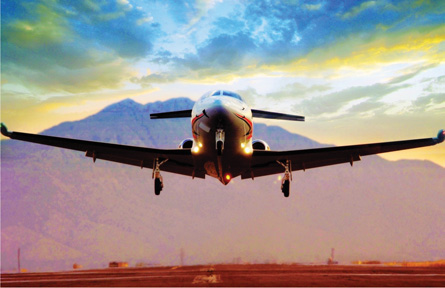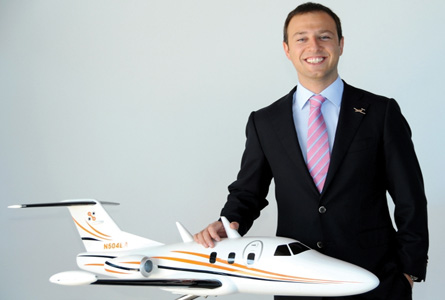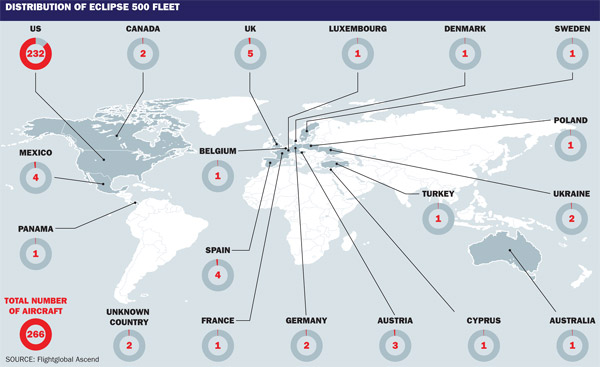Turkey's EA Aerospace was founded in 2009 by entrepreneur Ekim Alptekin to acquire a stake in defunct US airframer Eclipse Aviation - developer of the Eclipse 500 very light jet (VLJ).
The Istanbul-based company is now a major shareholder in the newly named Eclipse Aerospace and together with investor Mason Holland and airframer Sikorsky, has ambitious plans to grow the Albuquerque, New Mexico-headquartered venture.
 |
|---|
| © EA Aerospace EA Aerospace has become a dedicated service centre and distributor for the Eclipse |
"I have always believed in this product," says Alptekin, who owns an Eclipse 500 himself. "I had plans to build an air-taxi operation called MyJet with a fleet of up to 120 Eclipse 500s." The service was to span from Albania in the west to Kazakhstan in the east, Russia in the north and Africa in the south.
"The bankruptcy put a stop to the project, but I never lost faith in the aircraft and the air-taxi concept," he says.
GAME CHANGER
When it was launched in the late 1990s, the Eclipse 500 was revolutionary, Alptekin says. "Many of the company's stakeholders - such as Bill Gates - were high-profile, innovative business people. They shared founder Vern Raburn's vision to revolutionise personal aviation and be the first to serially produce a business jet," he adds.
This concept and vision, Alptekin concedes, is comparable with the Ford Model T. "Although this wasn't the first car on the market it was the first to be mass produced. Similarly, the Eclipse 500 was intended to be a commodity product brought to the masses by the throngs of air-taxi companies," he says.
The experiment initially seemed to pay off, with the company chalking up orders of more than 2,500 aircraft. As predicted, a plethora of nascent, evangelical air-taxi start-ups accounted for a substantial number of these sales, many in Europe.
Alptekin says 259 Eclipses were delivered in 18 months. "Throughout the last two months of production, the factory was building one aircraft a day. These numbers are a revolution in civilian jet-aircraft manufacturing."
BANKRUPTCY EFFECTS
However, Alptekin adds that demand was outstripping supply and 1,265 deposits had been secured before the administrators were called in.
"This was a really tough time for me," Alptekin says. "Through MyJet [and the 120-aircraft order], I had the largest unsecured creditor of the bankruptcy. A lot of the investors in the project were close friends. I lost a lot of money but I had to write it off."
People have questioned Alptekin's resolve to reinvest in an industry that made him bankrupt. However, he attributes this improbable decision to his unwavering belief in the Eclipse 500.
 |
|---|
| © EA Aerospace |
"Bankruptcy and the collapse of Eclipse created an idea in the market that the VLJ concept wasn't going to work," he says. "Eclipse's downfall had nothing to do with the product," he adds, rather it was because of "the company's financial mismanagement".
This failed to deter Alptekin: "Because I was originally involved as a customer I understand what the customer is looking for. So in September 2009, I decided to put my money where my mouth is and become a shareholder and a board member in the [resurrected] company."
EA Aerospace has also become a dedicated service centre and distributor for the Eclipse. The ownership structure is equal, Alptekin stresses. "Nobody has a majority share and all decisions are made jointly. The company is also debt free," he insists.
Despite the new owner's clear, long-term vision for the Eclipse and confidence in the product line, Alptekin admits it is still a struggle trying to alter people's tainted perceptions of the Eclipse brand.
"It is tough trying to convince people that we are a sound, well-run company," he says. "Yet we are financially secure and stable. The balance sheet is strong and profitable."
TURNAROUND
Sikorsky's decision last year to invest in the company boosted the Eclipse's credibility. "It was a clear indication that we're on the right track, but there is still a long way to go," Alptekin says.
And the most loyal customers are still angry, he admits. "They got their fingers badly burned and lost a lot of money. They are watching and waiting to see what happens. They want to see us producing more aircraft and building a global support infrastructure - and that is what we intend to do."
Since acquiring the company, the new shareholders have consolidated the supply chain in an attempt to keep the aircraft's price tag as low as possible. They have also converted about 200 of the Eclipse 500 fleet with homogenous equipment, including flight into known icing (FIKI).
"When we acquired the assets, the fleet was scattered in almost six different configurations with very few enjoying FIKI. Today, 80% of the fleet is fully upgraded," says Alptekin.

Sales of its Total Eclipse - unfinished or low flight-time aircraft that were sold as part of the bankruptcy agreement - are strong. "We have approximately 17 aircraft left," Alptekin admits. "The aircraft are fully stripped, many essential and expensive components [have been] replaced with brand-new components offering a brand-new value proposition. The market is viewing these [$2.15 million] aircraft as limited-edition aircraft."
Such is their confidence in the Eclipse product, shareholders last year launched an upgraded version of the VLJ called the Eclipse 550. The $2.7 million aircraft, which features synthetic vision and autothrottles, remains on target for service entry in the third quarter of 2013.
"We have already secured enough $25,000 orders to fulfil the first year's production," Alptekin says. "We will manufacture aircraft the way Eclipse intended. We would like to produce up to 600 aircraft a year but will be happy with 300 - this is an honest expectation," he adds.
Alptekin's belief in the point-to-point, pan-regional air-taxi model also remains as steadfast as ever. "There is a value proposition in offering a flight from A to B in a business jet if the aircraft and the flight are affordable and flexible," he says.
Alptekin cites "pent-up demand" for services in the Middle East and Turkey, where he is leasing two Eclipse 500s to local operator Seabird Airlines. The aircraft will join the company's 19-seat De Havilland DHC-3 Twin Otter this quarter. Three more of the VLJs will be added to the fleet by the end of the year.
"Demand for air travel is booming here in Turkey. People are looking for affordable and flexible transportation, which the Eclipse can provide with operating costs of only $600 an hour," says Alptekin.
Many Turkish travellers are "badly served" by the airlines, he says. "There are 54 airfields and airports available but 80% of these are underutilised," he adds.
Eventually mass personalised air travel will be the norm, Alptekin says. "People will want to travel to and from towns and cities not connected by traditional airlines. So there is a value proposition in offering a business jet service at a very competitive price.
"Once you have built up a critical mass of aircraft across your network, the whole system will slot into place."
Source: Flight International
















